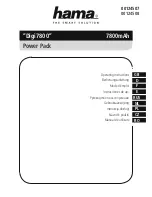
6
English
CAUTION
We suggest that you practice with your router before
installing a cutter and making cuts in wood.
ROUTING
For ease of operation and maintaining proper control, your
router has two handles, one on each side of the router
base. When using your router hold it fi rmly with both
hands.
Before starting the router, unplug it and make sure the
cutter is securely tightened in collet nut and that depth of
cut is properly set.
Plug router into power supply, turn it on, and let motor build
to its full speed, then gradually plunge or feed cutter into
workpiece. Do not let the cutter contact workpiece before
turning on router and allowing it to develop full speed.
ROUTING GROOVES
When routing across the face of boards, set router at
desired depth of cut, place the edge of router base against
workpiece, and turn on the router. Slowly feed the cutter
into the workpiece along desired line of cut.
WARNING
If desired depth of cut is greater than can be safely cut in
one pass, make cuts in two or more passes.
When routing straight cuts across stock, clamp a straight-
edge to the workpiece to use as a guide. Position the
straight-edge parallel to the line of cut and offset the
distance between the cutting edge of the cutter and the
edge of the router base. Hold the router base against the
straight-edge and rout the groove.
When routing a groove wider than the diameter of the
cutter, clamp a straightedge on both sides of the cutlines.
Position both guides parallel to the desired line of cut and
spaced equal distances from the desired edges of the
groove. Rout along one guide, then reverse direction and
rout along the other guide. Clean out any remaining waste
in the center of the groove freehand.
FITTING AND ADJUSTING THE PARALLEL GUIDE
See Figure 12.
Insert the parallel guide into the hole of the Router
base.
Draw a cutting line on the workpiece.
Lower the router body until the cutter is in contact with
the workpiece.
Postion the router on the cutting line. The outer cutting
edge of the cutter must coincide with the cutting line.
Without moving the router push the guide to the edge
of the workpiece before tightening the lock knob.
ROUTING BY FREEHAND
When used freehand, your plunge router becomes a
fl exible and versatile tool. This fl exibility makes it possible
to easily rout signs, relief sculptures, etc. There are two
basic techniques for freehand routing:
Routing letters, grooves, and patterns into wood.
Routing out the background, leaving the letters or
pattern raised above the surface.
When freehand routing, we suggest the following:
Draw or layout the pattern on workpiece.
Choose the appropriate cutter.
NOTE:
A core box or V-groove bit is often used for routing
letters and engraving objects. Straight bits and ball mills
are often used to make relief carvings. Veining bits are
used to carve small, intricate details.
Rout the pattern in two or more passes. Make the first
pass at 25% of the desired depth of cut. This process
will provide better control as well as being a guide for
the next pass.
Do not rout deeper than 1/8 in (3.2 mm) per pass or cut.
Follow these directions when routing by freehand:
Choose the appropriate cutter, set desired depth of
cut, carefully check set-up, and secure workpiece.
Make a test cut in a scrap piece of wood from the
same workpiece if possible.
Unlock plunge lock lever to raise cutter from any
preset depth of cut. This also permits raising cutter
inside router base.
Place router on workpiece inside pattern to be routed.
Grasp handles securely and press the switch to start
your router.
Let motor build to full speed, then gradually plunge
cutter into workpiece until stop bar comes into contact
with depth stop.
Lock plunge lock lever to secure depth of cut setting.
Begin routing out the pattern, continuing until a
complete pass at this depth of cut has been made.
WARNING
Do not use large router bits for freehand routing. Use
of large router bits when freehand routing could cause
loss of control or create other hazardous conditions that
could cause possible serious personal injury.
Содержание ERT1400RG
Страница 1: ...PLUNGE ROUTER OWNER S OPERATING MANUAL ERT1400RG...
Страница 3: ...Fig 7 Fig 8 Fig 9 Fig 10 14 30 1 2 12 11 10 10 11 33 9 9 9 34 12 10 8 9 8 Fig 5 Fig 6...
Страница 4: ...Fig 13 Fig 14 Fig 15 Fig 16 Fig 11 Fig 12 14 16 23 15 25 26 27 28 28 27...
Страница 5: ...Fig 17 32...
Страница 15: ...7 7521 1 8675 6 8675 37 7 HYHO RQFDVWHU 5RDG RQFDVWHU 9LFWRULD XVWUDOLD 7HO D 1R...

































